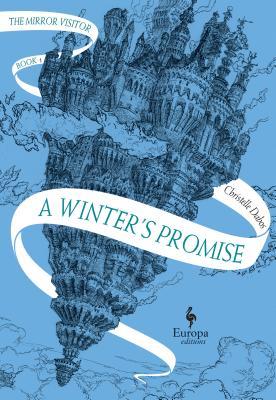 Title: A Winter's Promis
Title: A Winter's PromisSeries: The Mirror Visitor
Author: Christelle Dabos
Translated by: Hildegarde Serle
Source/Format: Borrowed from the library; Hardcover
More Details: Young Adult; Fantasy
Publisher/Publication Date: Europa Editions; September 25, 2018 (First published June 6, 2013)
Goodreads Amazon Barnes & Noble Book Depository
Synopsis from Goodreads...
Volume 1 of The Mirror Visitor Quartet; Winner of the Grand Prix de l’Imaginaire....
Where once there was unity, vastly different worlds now exist. Over each, the spirit of an omnipotent and immortal ancestor abides. Long ago, following a cataclysm called the Rupture, the world was shattered into many floating celestial islands, known now as arks. Ophelia lives on Anima, where inhabitants can read the pasts of objects. What’s more, she is also a “mirror-traveler,” possessing an ability that has been passed down to her through generations. Her idyllic existence on Anima is disrupted when she is promised in marriage to Thorn, an influential member of a distant clan. Still only a girl, Ophelia must leave her family and follow her fiancé to Citaceleste, the capital of a cold and icy ark called Pole. But there, her future husband seems indifferent to her and she slowly realizes that her presence on Pole is part of a much bigger plot and has far-reaching ramifications not only for her but for her entire world.
An unforgettable heroine, an insightful study of relationships, a rich and bountiful universe, intrigue and suspense, A Winter’s Promise is perfect for readers of Margaret Rogerson, Scott Westerfeld, Melissa Albert, and N.K. Jemisin....A Winter’s Promise is one of the best books I’ve read so far this year. True to its synopsis, this book reminded me a little of N.K Jemisin’s Broken Earth trilogy, but also of Howl’s Moving Castle. There was an element of domesticity present throughout the novel rather than a focus on weapon and or magic heavy battles. And you know what? That worked out perfectly fine. A Winter’s Promise is a story that suited the characters as much as the characters suited the world they inhabited—which was all around a fascinating setting. And while the end of the book yielded more questions than answers, A Winter’s Promise was an excellent beginning to The Mirror Visitor series.
One of the elements that initially drew me to A Winter’s Promise was the event known as the Rupture. There was a lot of mystery surrounding it, which persisted throughout the novel. However, there are sequels to A Winter’s Promise. I hope some of those answers will be provided as the series goes on, because the history of the setting was fascinating.
The overall premise is pretty simple: Ophelia ends up in an arranged marriage she can’t escape from, and she’s not exactly the biggest fan of her new fiancé. Yet, the plot was anything but simple, and it was something that became apparent as more of the details surrounding the engagement were revealed. The situation also afforded a direct look into the individual societies on the two arks prominently featured in the story. Anima, Ophelia’s home ark—while strict about their ways and the expectation placed on her about her engagement—was still almost idyllic in comparison to that of Thorn’s. Pole was like Anima’s polar opposite. On Anima, the weather was fair and everyone was like family. On Pole, it’s always cold and snowy, and there was a clear hierarchy with distinct classes of people. A point of interest for me was seeing how Ophelia would adapt, if at all, to the new environment.
The characters were also something to make note of. I won’t go into specifics since I don’t want to spoil anything, but I enjoyed reading from Ophelia’s perspective. The synopsis says “an insightful study of relationships,” and that’s what I got from the story. It was a character driven story, and a lot of time was devoted to exploring relationships as well as everyday happenings. I did like how seemingly innocuous abilities could have unintended consequences. One such effect was Ophelia’s clumsiness. Initially, it came off as a bit off-putting at times, but I did catch the details about the cause of it. Thorn was a mystery and mostly remained as one, and what information there was about him revealed hints of an interesting character. I hope to see more of him in the next book.
So, there are a number of questions I still have. Thus, I’m looking forward to The Missing of Clairdelune. Luckily, the wait won’t be too long…












